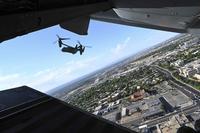If Congress adopted recommendations to overhaul the military retirement and health care systems, it would eventually save enough money to buy a new aircraft carrier every year, an analyst said.
Offering troops 401(k)-like retirement plans before they reach 20 years of service and replacing the existing Tricare program with a choice of commercial health insurance options were among 15 recommendations in a report released yesterday by the Military Compensation and Retirement Modernization Commission.
The proposals are estimated to save almost $4 billion a year beginning in 2018 and more than $12 billion a year starting around 2040, according to an appendix in the blue-ribbon panel's long-awaited report, which came after a two-year review.
"That's almost enough to buy a new aircraft carrier every year," Todd Harrison, a senior fellow defense budget analyst at the Center for Strategic and Budgetary Assessments, said during a press conference Friday at the think-tank in Washington, D.C.
For example, the USS Gerald R. Ford -- the first redesigned carrier in four decades and the first in a new class of ships that will replace the 10-ship Nimitz class launched in 1972 -- was christened in 2013 and estimated to cost about $13 billion.
"Not that we need a new aircraft carrier every year," Harrison added with a grin. "You could buy a lot of stuff with this money. But more importantly, think about how many people you could keep."
The Defense Department is shrinking the size of its armed forces, which number about 1.3 million troops, after more than a decade of war. The downsizing is fueled in part by automatic, across-the-board budget cuts known as sequestration. Getting rid of manpower has long been one of the easiest ways for Pentagon officials to save money.
The panel's recommendations came after extensive surveys of more than 150,000 active-duty troops, reservists and retirees, many of whom expressed a wish for more options when it comes to retirement and health care.
The vast majority of troops -- more than eight in 10 -- leave before the 20-year mark and thus don't receive any retirement pay. So the panel proposed lowering the full retirement benefit from 50 percent to 40 percent of final basic pay for careerists, and creating 401(k)-like Thrift Savings Plans for service members who plan on leaving the military and rolling over the savings into private-sector accounts.
Meanwhile, the commission also proposed doing away with the three Tricare plans for military families, reservists and working-age retirees, though none of its recommendations would affect Tricare for Life for elderly retirees. The new health care program, similar to the one for federal civilian employees, would allow recipients to choose from a list of commercial health care plans.
"They are a win-win," Harrison said of the recommendations. "They save ... a significant amount of money and ... [are] something that troops would actually prefer."
On the proposed fiscal 2016 budget, which is due out next week, Harrison said he was hopeful that the new Republican leadership on congressional defense panels, including Sen. John McCain of Arizona on the Senate Armed Services Committee, and Rep. William "Mac" Thornberry of Texas, his counterpart on the House Armed Services Committee, will pass legislation to improve the way the Pentagon buys weapons and equipment.
"I think we actually have a pretty decent chance of acquisition reform legislation getting pushed through this year," he said. "Not big, systemic change that would fundamentally reshape the acquisition system, but I would expect some bills that try to tweak the acquisition system here and there. That's something I'll be watching."








